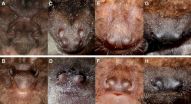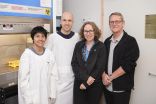(Press-News.org) Michigan hospitals participating in the American College of Cardiology's "See You in 7" program demonstrated important reductions in 30-day readmission rates for Medicare heart failure patients when compared to non-participating hospitals despite only modest increases in seven-day follow-up appointments, according to a study today in JACC: Heart Failure.
"See You in 7" is part of the ACC's Hospital-to-Home initiative, a national quality improvement program aimed at reducing heart disease-related hospital readmissions and improving the transition from hospital to home. "See You in 7" challenges hospitals to ensure all discharged heart failure and heart attack patients have a follow-up appointment scheduled within seven days of hospital discharge.
"Readmissions of heart failure patients remain one of the most important clinical challenges today," said JACC: Heart Failure Editor-in-Chief Christopher O'Connor, M.D., FACC. "Transitional care programs may represent our best opportunity to reduce the burden on patients and health systems."
Researchers looked at the seven-day follow-up and 30-day readmission rates for Medicare heart failure patients at 10 hospitals in the Southeast Michigan "See You in 7" Collaborative and compared them to non-participating hospitals both before joining the "See You in 7" program and after one year of participation.
The one-year program included three phases: implementation, intervention and evaluation periods. During implementation, hospitals selected at least one metric from the "See You in 7" toolkit to focus their efforts and measure progress.
Metrics included:
identify heart failure patients prior to discharge;
schedule and document a follow-up visit with a cardiology or primary care doctor within seven days of discharge;
provide patients with documentation of scheduled follow up;
identify and address barriers to keeping appointment;
ensure patients arrive at scheduled follow up appointment; and
make discharge summary available to follow-up health care providers.
At the end of the program, both participating and non-participating hospitals' seven-day follow-up rates increased but remained low--31 to 34 percent for participating hospitals and 30 to 32 percent for non-participating hospitals. However, adjusted 30-day readmission rates decreased substantially in participating hospitals compared to non-participating hospitals. Participating hospitals saw readmissions decrease 2.6 percent, while non-participating hospitals saw a 0.6 percent reduction.
"Our study clearly shows there are challenges in coordinating early follow-up care, since increases in seven-day post-discharge follow up were modest. However, despite this, hospitals in the program stepped up to address deficiencies in post-hospital care and reduce 30-day readmissions," said Sandra Marie Oliver-McNeil, DNP, ACNP-BC, a study author and assistant professor of nursing at Wayne State University. "Through collaboratively addressing the 'See You in 7' goals, hospitals participating in this program learned from each other when helping their patients transition from hospital to home, and they should serve as an encouraging example for other regional hospitals to share best practices."
According to the study, participating hospitals designated a staff member to document successful seven-day follow-up visits or investigate why the visits did not take place, leading to more engaged patients and caregivers and giving both sides a better understanding of barriers to care. These efforts may have led to the reduced 30-day readmission rates.
Medicare payments per patient also decreased in participating hospitals. Combined payments for inpatient and 30 days of post-discharge care decreased by $182 in participating hospitals and $63 in non-participating hospitals.
INFORMATION:
The American College of Cardiology is a 49,000-member medical society that is the professional home for the entire cardiovascular care team. The mission of the College is to transform cardiovascular care and to improve heart health. The ACC leads in the formation of health policy, standards and guidelines. The College operates national registries to measure and improve care, provides professional medical education, disseminates cardiovascular research and bestows credentials upon cardiovascular specialists who meet stringent qualifications. For more information, visit acc.org.
The barbastelle bat may emit two different types of weak echolocation signals alternately, one upward through the nose and one downward through the mouth, to find prey while undetected and to sufficiently keep track of the environment, respectively, according to a study published September 9, 2015 in the open-access journal PLOS ONE by Anna-Maria Seibert and colleagues from the University of Tübingen, Germany.
Barbastelle bats prey almost exclusively on eared moths, using "stealth echolocation" signals that are 10-100 times weaker than those of other aerial hawking ...
Clinical trials for a dengue fever treatment could start within a year, following a discovery by University of Queensland scientists.
UQ's School of Chemistry and Molecular Biosciences Head Professor Paul Young said the researchers had identified similarities in how the body reacted to dengue virus and bacterial infections, in a finding that would allow them to re-purpose existing drugs.
"We have discovered that the dengue virus NS1 protein acts as a toxin in the body, in a similar manner to the way bacterial cell wall products lead to septic shock in bacterial infections," ...
US fans of the National Football League (NFL) and sports reporters assigned to specific teams have unrealistic expectations about how well their team will perform, finds new research from UCL and Oxford University.
The study, published in PLOS ONE, also reveals which teams are most liked and disliked, as well as which teams have the most optimistic fans.
The main results are from an April 2015 survey of 1,116 US-based NFL fans, who were asked to predict how many games their favourite and least favourite teams would win in the 2015 season. As each team plays 16 games ...
New research suggests that offering financial incentives for farming industries to mitigate the impact agriculture has on the environment, by reducing fertiliser use and 'sparing' land for conservation, for example, actually has a positive effect on critical areas such as greenhouse gas reduction and increased biodiversity.
It has been a point of contention whether such 'cash for conservation' initiatives succeed. For the latest study, researchers aggregated investment in environmental incentives at a national level for the first time, and, by comparing them to broad ...
COLUMBUS, Ohio - A new study suggests that changes in immune function can occur as long as five years before the diagnosis of a brain tumor that typically produces symptoms only three months before it is detected.
Using blood samples collected an average of 15 years before brain tumor diagnosis to analyze interactions between 12 allergy-related proteins, researchers looked at how those relationships differed between people later diagnosed with brain tumors and cancer-free controls.
Among people who were subsequently diagnosed with this brain tumor, called a glioma, ...
The Wilson Center's Science and Technology Innovation Program (STIP) is releasing a five-episode video series looking at the potential for additive manufacturing to transform how we build things - and what we need to do to fully realize this potential.
Beyond the Desktop explores how additive manufacturing could affect the fields of medicine, aerospace, space technology and more. Beginning Sept. 9, 2015, a new episode will be released each Wednesday through early October. Episodes will be posted on the Wilson Center homepage: https://www.wilsoncenter.org/3dprinting
Many ...
Researchers have shown for the first time that phytoplankton (plant life) in remote ocean regions can contribute to rare airborne particles that trigger ice formation in clouds. Results published this week (Wednesday 9 September) in the journal Nature show that the organic waste from life in the oceans, which is ejected into the atmosphere along with sea spray from breaking waves, stimulates cloud droplets to freeze into ice particles. This affects how clouds behave and influence global climate, which is important for improved projections of future climate change.
Clouds ...
CAMBRIDGE, Mass.--The Dirac cone, named after British physicist Paul Dirac, started as a concept in particle and high-energy physics and has recently became important in research in condensed matter physics and material science. It has since been found to describe aspects of graphene, a two dimensional form of carbon, suggesting the possibility of applications across various fields.
Now physicists at MIT have found another unusual phenomenon produced by the Dirac cone: It can spawn a phenomenon described as a "ring of exceptional points." This connects two fields of ...
Putnam Valley, NY. (Sept. 9, 2015) - Alzheimer's disease (AD), which affects an estimated 26 million people worldwide, is the fourth leading cause of death among the elderly and the leading cause of dementia. Predictions are that the number of AD cases will quadruple by 2050.
Although pharmacological methods for treating AD have been discovered, none significantly delay the progression of the disease. However, cell transplantation research using animals modeled with AD has indicated that human umbilical cord blood cells (HUCBCs) can ameliorate some cognitive deficits ...
The high frequency and magnitude of volcanic eruptions could have been the cause of the progressive cooling of ocean surfaces over a period of 1,800 years. This is made apparent in an international study published recently in the journal Nature Geoscience, involving researcher P. Graham Mortyn of the Institute for Environmental Science and Technology (ICTA-UAB) and the UAB Department of Geography.
The study emphasises that this trend came to an end with the beginning of the Industrial Revolution and the resulting global warming caused by human activity. It further shows ...


